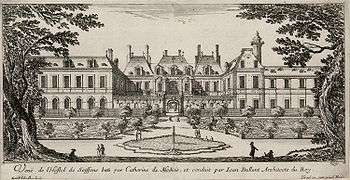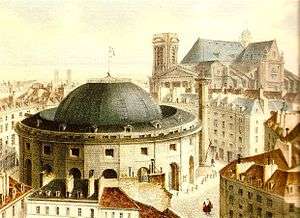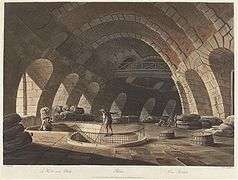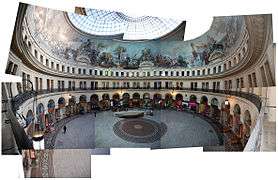Bourse de commerce (Paris)
The Bourse de commerce (Commodities Exchange) is a building in Paris, France, originally used as a place to negotiate the trade of grain and other commodities, now used to provide services to businesses by the Paris Chamber of Commerce. It has its origins in a circular corn exchange built in 1763–67, with an open-air interior court that was capped by an iron dome in 1811. In a major reconstruction in 1888–89 much of the structure was replaced, although the layout remained the same and the dome was retained with modifications. The dome of the building is listed as a historical monument.
| Bourse de commerce | |
|---|---|
 Bourse de commerce and the Médici column | |
 | |
| General information | |
| Type | Hall |
| Classification | Historical monument |
| Address | 2, rue de Viarmes |
| Town or city | Paris (1st arrondissement) |
| Country | France |
| Coordinates | 48.862731°N 2.342780°E |
| Design and construction | |
| Architect | François-Joseph Bélanger |
| Engineer | François Brunet |
| Website | |
| web | |
History
Early buildings
Between 1574 and 1584 Jean Bullant (1515–78) built a hôtel particulier (grand house) on the site for Catherine de' Medici (1519–89).[1] A tower with an encaged observation platform, now called the Medici column, was built beside the hôtel from which observations of the stars could be made for astrological purposes. The Queen's hôtel was bought by Charles de Bourbon-Condé, Count of Soissons, who repaired and enlarged it. The hotel became called the Hôtel de Soissons. The indebted last owner was Victor Amadeus of Savoy (1690–1741). After his death the hotel was demolished in 1748 and the materials sold to pay the creditors. The city of Paris bought the column from its first owner, Laurent Destouches, which saved it from destruction.[2]
Between 1763 and 1767 the City of Paris built a circular building on the site for the storage and sale of wheat.[2] The Halle aux blés (Corn Exchange) was designed by Nicolas Le Camus de Mézières with a circular central courtyard and a double staircase. The layout of that building has been retained.[1] From 1782 to 1783 a wooden dome was built to a design by Jacques-Guillaume Legrand and Jacques Molinos based on the principles defined by Philibert de l'Orme. On 16 October 1802 the cupola was destroyed by fire.[1] A new design by François-Joseph Bélanger for an iron dome covered in sheets of copper was selected after some controversy.[1] Victor Hugo described the dome in his 1831 novel Notre-Dame de Paris as an English jockey-cap on a large scale.[3] The corn exchange was closed in 1873. In 1885 the building was assigned to the Commodities Exchange.[2] Until then the exchange had been housed in the Palais Brongniart.[4]

 Corn exchange in 1838
Corn exchange in 1838 Vaulted attic of the corn exchange
Vaulted attic of the corn exchange
1886 renovation

In 1885 Henri Blondel began a major renovation of the building.[1] Construction took place between 1888 and 1889. It incorporated elements from the Hôtel de Soissons, from the Halle aux blés of Nicolas Le Camus de Mézières and from the second cupola covering that hall by Belanger. The building designed by Blondel still had a circular shape, with 25 bays separated by two pilasters.[5] Blondel retained but modified the cupola.[1] The 18th century double staircase was also retained.[6]
The entrance portico is surmounted by a pediment supported by four fluted Corinthian columns on which three allegorical figures by the sculptor Aristide Croisy represent the City of Paris flanked by Trade and Abundance.[2] The interior of the rotunda was decorated by the painters Alexis-Joseph Mazerolle, Évariste Vital Luminais, Désiré François Laugée, Georges Clairin and Hippolyte Lucas.[5] Painted panels depict characters that symbolize North, East, South and West, and frescoes represent the history of trade between the five continents.[2]
Recent years
The City of Paris sold the building to the Paris Chamber of Commerce for one symbolic franc in 1949.[2] The murals and cupola were classified as a historical monument on 15 January 1975.[5] A major renovation was undertaken in 1989.[2] The murals were restored in 1998.[7] The building may be reached by metro from the stations Louvre – Rivoli and Les Halles, and by Réseau Express Régional from the Châtelet les Halles station.[8]

Usage
The Syndicat Général de la Bourse de commerce de Paris (General Union of the Paris Commodities Exchange) was created in 1854.[9] Many futures markets functioned at the Commodities Exchange from its inception, at first under the control of syndicates for wheat, rye and oats, flour, oil, sugar, alcohol and rubber. The collapse of wheat prices in 1929 led to the reform of 1935 that created the Compagnie des Commissionnaires, confirmed by law in 1950. After the World War II (1939–45) the futures markets were opened gradually to international trading in goods such as white sugar, cocoa, coffee, potato, soybean meal, rapeseed. These were traded in auction lots. The negotiations were managed and controlled successively by the Compagnie des Commissionnaires Agréés, by the Banque Centrale de Compensation and then by MATIF (Marché à Terme International de France).
With the computerization of futures markets, in 1998 market activity ended at the Bourse de Commerce building. The exchange continues as an electronic market within Euronext. On 1 January 2013 the Chambre de commerce et d'industrie départementale de Paris was created as a division of the CCI de région Paris Ile-de-France. It has its headquarters at 2 Place de la Bourse and operational services at the Bourse de commerce. As of 2015 there were 36 elected officials and a staff of 125 people. The CCI Paris acts as an advocate for business in Paris, and provides support to company creators, marketers and business leaders.[10] Almost all of the building is now occupied by the Paris Chamber of Commerce and Industry, which manages it and offers services such as support for business creation. Exhibitions are held regularly in the space under the dome.
The Syndicat Général continues to facilitate dialog and interactions between companies involved in aspects of the cereals and oil seeds trade, including collection, transportation, storage, crop protection and finance. In 2015 the Syndicat Général changed its name to Agro Paris Bourse. It is part of the Consortium of European Exchanges, headquartered in Strasbourg. In 2012 there were 350 enterprises associated with the Bourse, which is based in the Bourse de commerce building.[9]
- Detail of the cupola
- Interior of the cupola
 Interior
Interior- Forum des Halles and Bourse de Commerce
Notes
- Bourse de Commerce – Structurae.
- Hillairet 1978.
- Bourse de Commerce – Time Out.
- Colling 1949, p. 301.
- Bourse de commerce – Mérimée.
- Poussez les portes ... CCI Paris.
- Bourse de Commerce – Lonely Planet.
- Bourse de Commerce – CCI Paris.
- Présentation – Agro Paris Bourse.
- La CCI Paris – CCI Paris Ile-de-France.
| Wikimedia Commons has media related to Bourse de commerce de Paris. |
Sources
- "Bourse de Commerce" (PDF) (in French). CCI Paris Ile-de-France. Retrieved 2015-09-19.
- "Bourse de Commerce". Lonely Planet. Retrieved 2015-09-19.
- "Bourse de commerce". Mérimée (in French). Ministère de la Culture (France). Retrieved 2015-09-18.
- "Bourse de Commerce - Paris 1e". 1900larnouveau (in French). Retrieved 2015-09-18.
- "Bourse de Commerce". Structurae (in French). Retrieved 2015-09-18.
- "Bourse de Commerce". Time Out. Retrieved 2015-09-19.
- Colling, Alfred (1949). La Prodigieuse Histoire de la Bourse. Paris: Société d'éditions économiques et financières.CS1 maint: ref=harv (link)
- Hillairet, Jacques (1978). "Connaissance du Vieux Paris" (in French). Editions de Minuit. Retrieved 2015-09-19.CS1 maint: ref=harv (link)
- "La CCI Paris". CCI Paris Ile-de-France. Retrieved 2015-09-20.
- "Poussez les portes de l'hôtel Potocki et de la Bourse de commerce" (in French). CCI Paris Ile-de-France. Retrieved 2015-09-20.
- "Présentation" (in French). Agro Paris Bourse. Retrieved 2015-09-19.